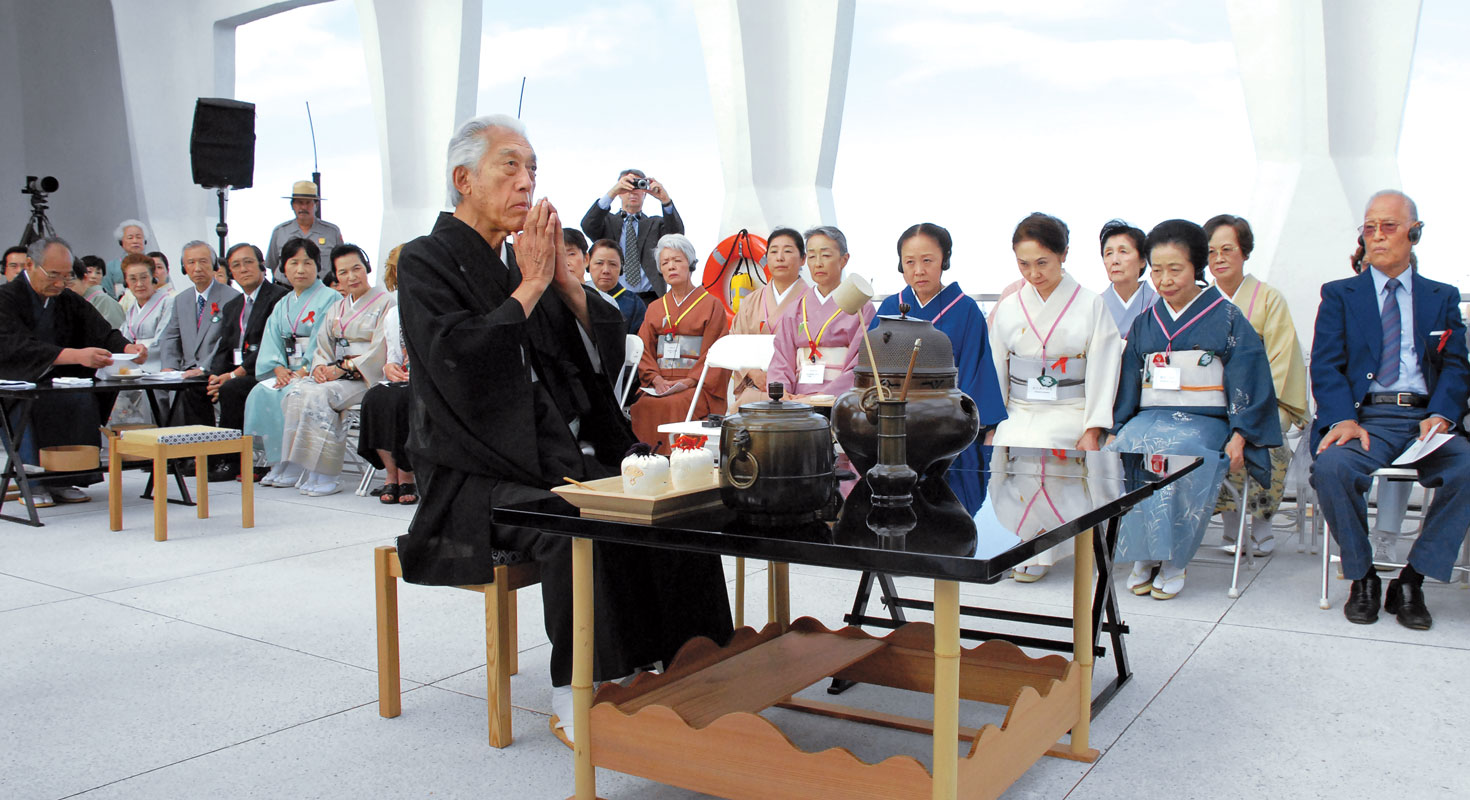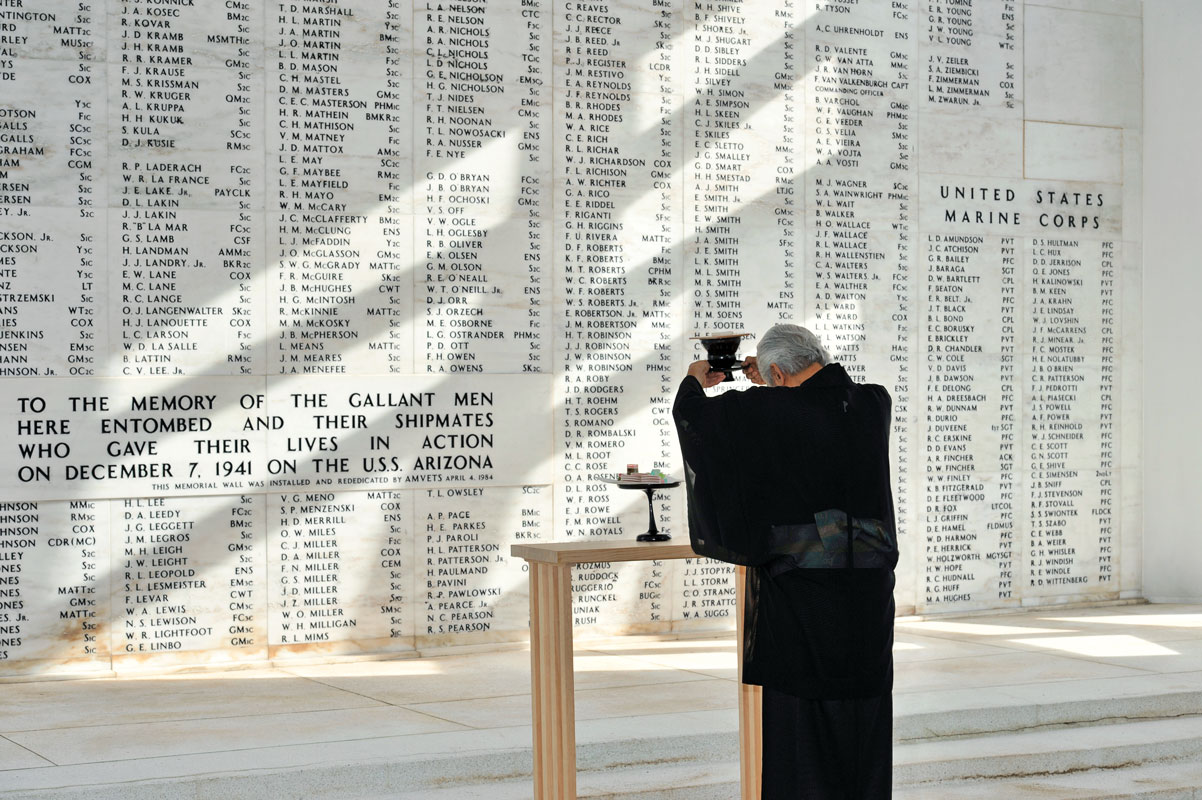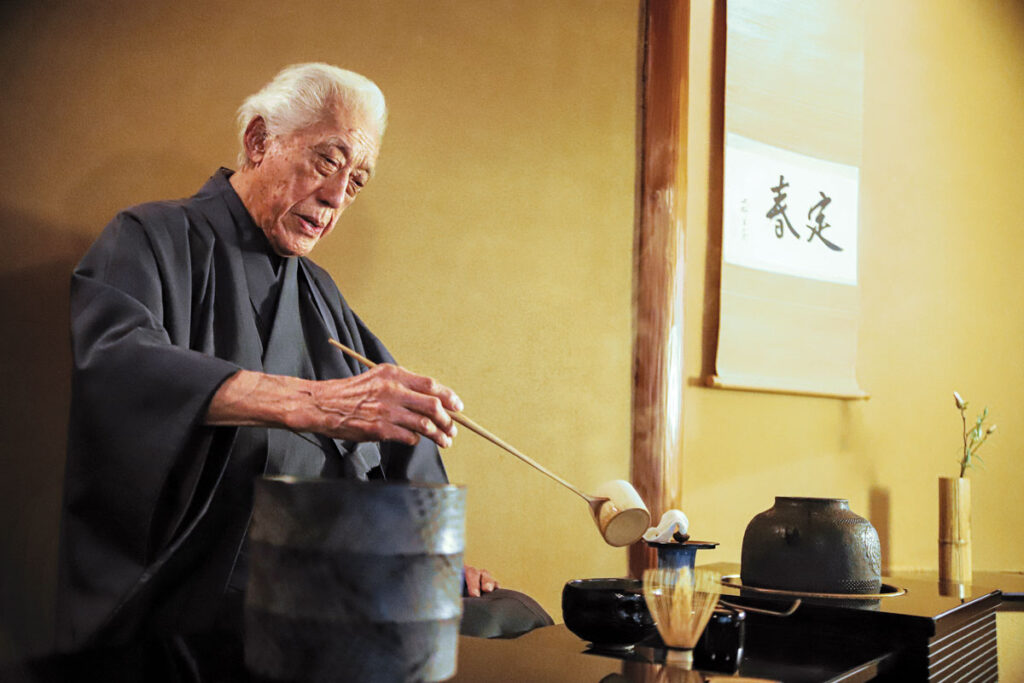In July 2011, Genshitsu Sen, the former grandmaster of the Urasenke tea tradition and a member of RC Kyoto, Japan, travelled to Hawaii, where 60 years earlier he had established the first Urasenke chapter outside his native land to promote the practice of chadō— literally, “the Way of Tea” — and through it, to spread the message of peace, reconciliation and brotherhood.

On that trip, Sen had a special mission. He had been invited to perform a devotional tea offering ceremony at the USS Arizona Memorial in Pearl Harbor to console the souls of all the war dead. The media hailed it a symbol of the healing process between the US and Japan, whose bitter enmity had cost so many lives and massive destruction during World War II.
For Sen, this tea offering ceremony was also very personal.
In 1943, he was drafted into the Imperial Japanese Navy and became a pilot in its air force division. In the last days of the war, the Japanese naval command assigned him to the Special Attack Force, which was tasked to fly suicide missions against Allied naval vessels. Fortunately, a hidden hand intervened to save him, but before he could discover who had kept him from climbing into a cockpit for the last time, the end of the war arrived. Many of his comrades had plunged to their death, taking the lives of an estimated 7,000 American, British, and Australian sailors. The toll among the attacking pilots was also severe — as many as 3,800 flew to certain death.
The faces of those comrades still live in Sen’s memory, along with the other ghastly consequences of war. After it was over, he dedicated his life to rebuilding peace and harmony in the world, an ideal deeply embedded in the tea ceremony.
At Pearl Harbor, early in the morning of July 19, 2011, Sen was ushered into the gleaming white, open air memorial that is built above the sunken hull of the Arizona. Nearly half of those killed in Japan’s surprise attack on December 7, 1941 were members of the Arizona crew. Of the 1,177 fatalities aboard the ship, the remains of 1,102 crew members still lie entombed in the wreck. A news clip of Sen’s visit shows the grandmaster moving purposefully, dressed in a black kimono which hung starkly beneath his solemn expression and thick mane of silver hair. He wore white split-toed socks in the Japanese tabi fashion. The elaborate tea service was laid out on a lacquered black table in the centre of the assembly room, where more than 200 Japanese and American guests, including politicians, war veterans, civic leaders, and Urasenke chadō practitioners, were gathered to witness the time-honoured Japanese ritual.

Employing a piece of square silk cloth known as fukusa, he purified the tea implements before placing green tea powder in a ceremonial bowl and ladling in hot water from a steaming kettle. With a bamboo whisk, Sen prepared two sacred portions — one koicha, or “thick tea,” and one usucha, or “thin tea.”
Once each bowl was prepared, he carried them to the memorial’s inner shrine, where the names of American sailors who perished during the attack are carved into a towering memorial wall. There, he lifted his head toward the heavens and raised the bowl in outstretched arms as an offering to those lost souls. After a time, he lowered the bowl to a wooden offering table. Then, Sen joined his hands in prayer to make a final silent entreaty. He called into that hall, and into the hearts of the congregation, the spirit of peace and reconciliation. All eyes were on him and, in silence, the symbolism was deafening.
“I have lived 88 years, and this event here today is going to be the most memorable event for me personally,” Sen said at the end of the ceremony, adding that it is the responsibility of those alive today to confront the past and carry its lessons into the future.
Edwin Futa, a Japanese American who is originally from Hawaii, has known Sen for more than two decades. The tea offering at Pearl Harbor resonated with Rotary members around the world, says Futa, who served as RI general secretary from 2000–11. “The event was broadcast in 32 countries, and many Rotarians, including myself, watched it or read about it. What Sen did embodies Rotary’s perpetual quest for peace and our efforts to overcome division.”
Kyoto: capital of peace and tranquility
Surrounded on three sides by mountains, Kyoto was the seat of the imperial court from 794 until 1868, when Emperor Meiji moved the country’s political centre to Tokyo. Kyoto’s deep history has endowed the city with 1,600 classic Buddhist temples, 400 Shinto shrines, palaces, gardens, and architectural treasures. Artistic expressions such as kabuki, geisha and ikebana (flower arrangements) flourished here, along with the martial traditions of samurai warriors.
During World War II, Kyoto was reportedly placed near the top of the list as a potential target for an atomic bomb attack. However, Henry L Stimson, the US secretary of war, maintained that the city should be spared, fearing outrage from the Japanese people and the international community for destroying a city that stood as a shrine of Japanese art and culture. And second, though he never publicly acknowledged this motivation, Stimson had visited Kyoto with his wife in the 1920s and came away impressed by its beauty.
Call it realpolitik or sentiment. Either way, the first atomic bombs used in war rained down their massive destruction on Hiroshima and Nagasaki, and the glory of Kyoto was preserved. A cultural and spiritual hub, Kyoto today is a living museum of Japanese traditions, among them the ancient tea ceremony. The city is home to Japan’s three prominent chadō schools, including the institution known as Urasenke.
Konnichian: “Hut of This Day”
A light spring rain is falling on Kyoto’s traditional wooden buildings with curving, elongated roofs, and its lush bamboo thickets are shrouded in mist, adding a mystical air to the tranquil gray surroundings.
Sen lives at the historical Urasenke Konnichian (Hut of This Day) tearoom compound in Kyoto, and the estate was established in 1646.
The cedar-roofed entry gate resembles a samurai helmet. From the gate, visitors follow a stone path that winds through a leafy green garden under a canopy of neatly manicured pines. By passing through the garden, it is expected that chadō participants leave all their worldly thoughts and desires behind as part of the transition from the stressful materialistic world to the sublime tranquility of a chadō gathering.
At the end of the path lies the porch of the main building, which houses a variety of rustic tea rooms with plain clay walls. The unadorned architecture conveys the dignity of the family’s ancestry of tea masters. The building’s overall aesthetics mirror those of the Japanese chadō itself — simplicity, subtlety, and a deep sense of regard for nature and human fellowship.
Inside a small tea room, sliding doors made of wooden lattice and covered in a translucent Japanese paper allow natural light to filter in from the gardens just beyond. A lacquered black table cut low to the floor stands toward the back and is set with tea-making implements. In the centre of the room lies a hearth where glowing charcoal keeps the chill of the morning at bay. A lone incandescent lamp bathes the room with soft light, creating a solemn and mysterious atmosphere.
Sen, dressed in a grey robe, strides into the room, standing straight and putting his visitor at ease with his cheerful and sonorous laughter. Standing straight at 5ft 10 inches, he radiates the dignity of character for which he is known. His thick grey hair is combed neatly to the back, rendering his long eyebrows more prominent. His eyes exude gentility and warmth. One is intensely aware that Sen, having turned 99 in April, has witnessed many turbulent events of the 20th century. He is an oracle of history. One can’t help bowing to his wisdom, vision and humanity.
Urasenke traditions meet Rotary values
The conversation starts with Rotary. “I tell you, Rotary is a large part of my life,” he says, his eyes sparkling. “My father introduced me to Rotary in 1954, when I was 31. I had a feeling that I would never be able to live my life without it. Rotary’s values fit perfectly with the tenets of our Urasenke chadō tradition, such as Wa (harmony), Kei (respect), Sei (purity) and Jaku (tranquility). Therefore, as soon as my father spoke to me about the philosophy of Rotary, I already considered myself a member. Not long after, I joined RC Kyoto. I remember some senior members telling me that Rotary should not be a place for merely fun and enjoyment, but a place for self-cultivation, learning and serving our community. These words ring in my ears to this day, motivating me to dedicate my life to service and to reach out into the unknown and face challenges.”

“In 1954, I helped charter a new club in Kyoto — RC Kyoto-South. Many prominent people in the community joined. I realised that to grow Rotary, we had to take action to help our community. Our accomplishments needed also to be recognised by our community. That was very important. Our club was chartered at the time of Japan’s economic takeoff. The unbridled pace of economic development was poised to threaten our city. Many historical monuments and cultural sites faced demolition, and our environment suffered severe damage.”
Sen and his fellow Rotary members reached out to the media to educate the public and businesses about the importance of preserving historical sites and the environment. His club hosted symposiums, inviting politicians, businesses and civic leaders for policy discussions. As a result, they were able to stop or divert construction projects that could have damaged or even erased Kyoto’s historic character. “We became a strong community voice, and RC Kyoto-South quickly gained the trust and support of the people,” he says.
In 1964, upon the death of his father, Sen acceded to the position of Urasenke grandmaster, representing the 15th generation in the Urasenke line. Despite his new responsibilities, he remained a dynamic member of Rotary and was elected president of the RC Kyoto.
Sen’s work gained him wide recognition in the Rotary world. He served as an RI director from 1988 to 1990 and a TRF trustee from 1998 to 2002. In 2003–04, he chaired the committee for that year’s RI Convention in Osaka, which drew more than 45,000 people from around the world, setting an attendance record. Promoting peace was a dominant theme; Sadako Ogata, a former Rotary Ambassadorial Scholar and United Nations High Commissioner for Refugees, told the audience that her experiences as a scholar helped her understand the causes and consequences of conflict
A life to honour those lost
Sen’s peacebuilding mission was born of his experience in World War II. In 1943, He was a sophomore at the Kyoto-based Doshisha University when he entered the Imperial Japanese Navy’s air force. A year later, in October 1944, when Japan was losing the war, the navy began forming the Special Attack Force. Sen joined 200 of his comrades in training for suicide missions designed to sink enemy ships with aircraft filled with explosives. But on the day appointed for his suicide run, as Sen was braced for death, a superior officer, out of the blue, scratched Sen’s name off the mission roster. The officer ordered him to stand down despite his repeated pleas to join his comrades. Instead, Sen was dispatched to a military unit in western Japan. After the war, Sen met with a former senior officer and asked why he had been spared. The officer replied, “Think of it as your destiny.” This is the burden Sen now carries with grace.
“It was a terrible feeling to have survived,” he says. “My fellow officers and friends died, and my wife also passed in 1999, leaving me alone. For this reason, I often have an inexplicable feeling that I have inherited the time of my comrades and those who should have lived. They transferred their lives to me. For their sake, I must also persevere, live well, and live long enough to fulfill my destiny.”
Sen tilts his head upward and closes his eyes. An aura of sadness replaces his good humour as joy surrenders to a sense of loss and the isolation of old age.
After a brief moment, the silence ends. The cloud lifts. Sen opens his arms with a smile and says with the enthusiasm of a young man: “Because of the loss, I feel that Rotary is my family. It relieves me of my loneliness and makes me feel cherished. Whenever I attend club activities and meet with young Rotary members, I feel especially close to them, as if I were at home with my children. I thank Rotary and the chadō for making me young and giving me love and energy.”
Pictures: Minmin Wu
© Rotary
Drinking tea with the master
As for the secret of his longevity, Sen says he neither smokes nor drinks. When he was young, he dabbled in martial arts (judo) and trained for many years as an equestrian. In 1967, he was chosen as a reserve rider for Japan’s national equestrian team, and has long served as president of the Japan Equestrian Federation. In 2008, he accompanied the Japanese equestrians to the Summer Olympics in Beijing.
In all these endeavours, “Tea drinking calms my mind,” he says, while demonstrating the Urasenke style of teamaking. “When my mind is quiet, I read books, which enriches my knowledge and helps me concentrate.”
Our tea prepared, Sen asks, “How is the taste?”
The lustrous concoction comprises a thick foam over the dark mixture of powdered green tea beneath. There is a sweetness in the astringency. Each sip brings a new sensation, the taste luxurious, but refined with a distinct flavour of the season.
The talk turns to Russia’s invasion of Ukraine — Sen had been invited to address a group of 200 young Rotary members at the Hotel Okura in Kyoto about humanitarian relief efforts undertaken by Japanese clubs and districts. “The tragedy of my early years is repeating itself,” he sighs.
While donations to help the people of Ukraine are important, Sen believes that moral and spiritual support are equally needed. “Young people need to be more vocal in their opposition to wars,” he says. “We must not forget about those who died during World War II. We are here today because of their sacrifice.”
It is approaching noon. The morning mist has dissipated. A ray of sunshine announces itself by lighting up the shoji paper of the sliding doors. The damp air, along with the lingering fragrance of fresh soil and new plant life in the garden, reinforces the sense of serenity that envelops the place.









